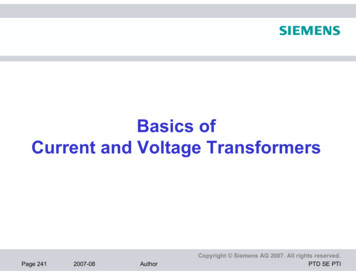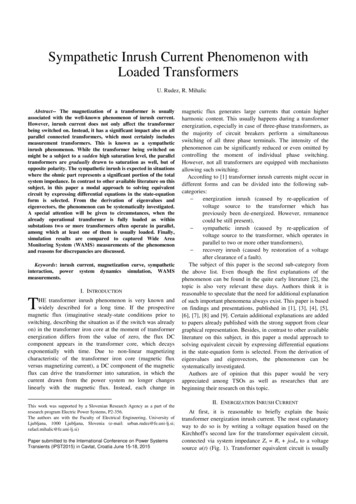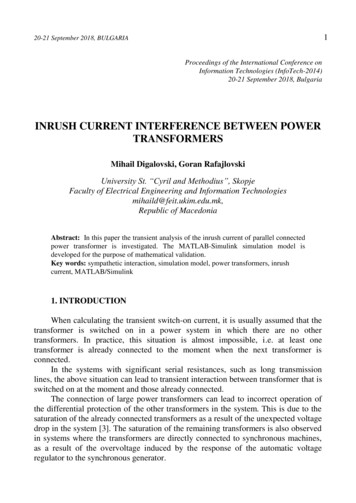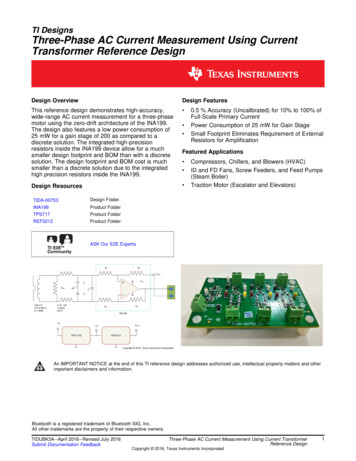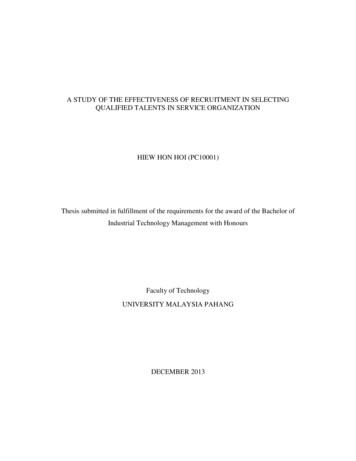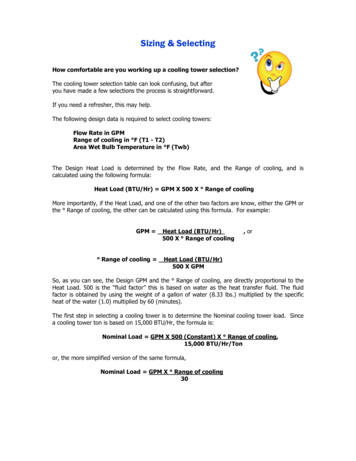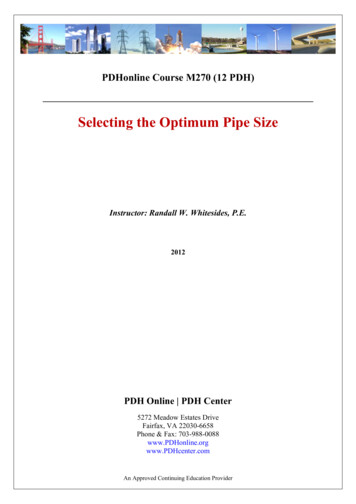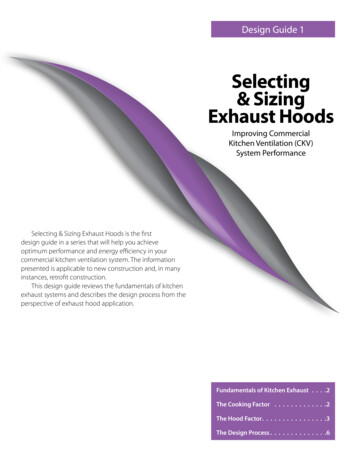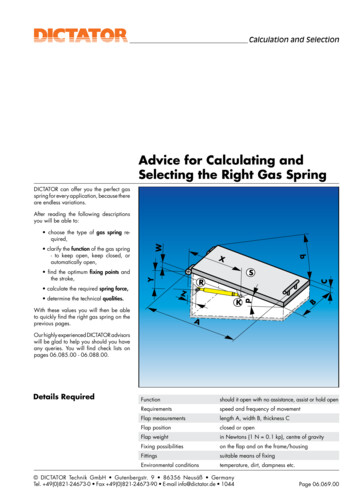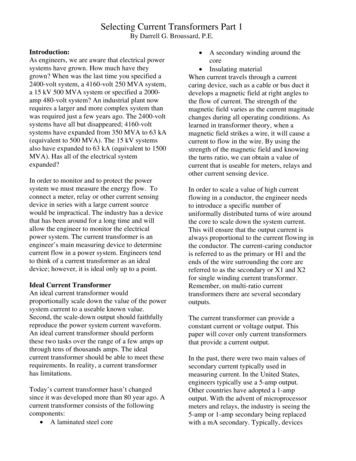
Transcription
Selecting Current Transformers Part 1By Darrell G. Broussard, P.E.Introduction:As engineers, we are aware that electrical powersystems have grown. How much have theygrown? When was the last time you specified a2400-volt system, a 4160-volt 250 MVA system,a 15 kV 500 MVA system or specified a 2000amp 480-volt system? An industrial plant nowrequires a larger and more complex system thanwas required just a few years ago. The 2400-voltsystems have all but disappeared; 4160-voltsystems have expanded from 350 MVA to 63 kA(equivalent to 500 MVA). The 15 kV systemsalso have expanded to 63 kA (equivalent to 1500MVA). Has all of the electrical systemexpanded?In order to monitor and to protect the powersystem we must measure the energy flow. Toconnect a meter, relay or other current sensingdevice in series with a large current sourcewould be impractical. The industry has a devicethat has been around for a long time and willallow the engineer to monitor the electricalpower system. The current transformer is anengineer’s main measuring device to determinecurrent flow in a power system. Engineers tendto think of a current transformer as an idealdevice; however, it is ideal only up to a point.Ideal Current TransformerAn ideal current transformer wouldproportionally scale down the value of the powersystem current to a useable known value.Second, the scale-down output should faithfullyreproduce the power system current waveform.An ideal current transformer should performthese two tasks over the range of a few amps upthrough tens of thousands amps. The idealcurrent transformer should be able to meet theserequirements. In reality, a current transformerhas limitations.Today’s current transformer hasn’t changedsince it was developed more than 80 year ago. Acurrent transformer consists of the followingcomponents: A laminated steel core A secondary winding around thecore Insulating materialWhen current travels through a currentcaring device, such as a cable or bus duct itdevelops a magnetic field at right angles tothe flow of current. The strength of themagnetic field varies as the current magitudechanges during all operating conditions. Aslearned in transformer theory, when amagnetic field strikes a wire, it will cause acurrent to flow in the wire. By using thestrength of the magnetic field and knowingthe turns ratio, we can obtain a value ofcurrent that is useable for meters, relays andother current sensing device.In order to scale a value of high currentflowing in a conductor, the engineer needsto introduce a specific number ofuniformally distributed turns of wire aroundthe core to scale down the system current.This will ensure that the output current isalways proportional to the current flowing inthe conductor. The current-caring conductoris referred to as the primary or H1 and theends of the wire surrounding the core arereferred to as the secondary or X1 and X2for single winding current transformer.Remember, on multi-ratio currenttransformers there are several secondaryoutputs.The current transformer can provide aconstant current or voltage output. Thispaper will cover only current transformersthat provide a current output.In the past, there were two main values ofsecondary current typically used inmeasuring current. In the United States,engineers typically use a 5-amp output.Other countries have adopted a 1-ampoutput. With the advent of microprocessormeters and relays, the industry is seeing the5-amp or 1-amp secondary being replacedwith a mA secondary. Typically, devices
Selecting Current Transformers Part 1with mA output are called “current sensors,” asopposed to current transformers.Type of Current TransformersCurrent transformers are available in severaldifferent styles. Engineers can choose from thefollowing: Bushing type, Window or Donut Wound type Bar typeBy far, the most common one is the wound typecurrent transformer. The wound type providesexcellent performance under a wide operatingrange. Typically, the wound type is insulated toonly 600 volts. The bushing type is typicallyused around the bushing on circuit breakers andtransformers and may not have a hard protectiveoutside cover. Bar types are available withhigher insulation levels and are usually bolted tothe current caring device.Typical Donut Type Current TransformerDonut type current transformers are typicallyinsulated for 600 volts. To ensure accuracy, theconductor should be positioned in the center ofthe current transformer opening.GE Consumer & IndustrialSpecification Engineer SeriesTypical Bar Type Current TransformerBar type current transformers are insulatedfor the operating voltage of the system.Current transformers are applied in two verydifferent functions, metering and/orprotection.Metering AccuracyThe accuracy class of a current transformeris expressed as the percent error for a knownburden, current and power factor. ANSIC57.13-1993 Table 11 defines the standardburdens for current transformers with 5-ampsecondary. The standard percent errorexpressed in Table 11 are 0.3, 0.6, and 1.2,and the standard metering burdens are 0.1,0.2, 0.5, 0.9 and 1.8 ohms at 60 Hz, 90%power factor lagging. In order to study thefull range of normal operation, engineersshould determine the accuracy at 10% and100% load conditions.As an example, a current transformer with ameter accuracy of 0.6B0.5 would indicate astandard burden of 0.5 ohms and a loadpower factor between 0.6 and 1.0. First, at100% primary current the error in the meterreading due to the current transformer willbe less than /- 0.6%. Second, at 10%primary current the error in the meterreading due to the current transformer willMay 2008
Selecting Current Transformers Part 1be less than /- 1.2%. The code allows the errorat 10% primary current to be no more than twicethe error at 100% primary current.Relay AccuracyFor relay classification engineers rely on thesecondary terminal voltage, which the currenttransformer can maintain at 20 times ratedsecondary current without exceeding 10% ratiocorrection. For a 5-amp current transformersecondary, that would be 100-amps. ANSIC57.13-1993 offers the following standardterminal voltage ratings as 10, 20, 50, 100, 200,400, and 800 volts. ANSI C57.13 only indicatedthe current transformer is capable of supplyingthe value indicated. A current transformer with a50-volt rating will supply at least 50 volts but isnot capable of supplying 100 volts. It may verywell be able to supply 95 volts. Always calculatethe actual voltage capability for the currenttransformer in use.In addition to voltage classification, ANSIC57.13 assigns a letter to precede the voltageclassification. It uses a “C” or “T” to define themanner in which the rating is established. Whenthe leakage reactance is low and does not havean appreciable effect on the ratio the standardassigns a “C” for calculated value. Bar-type andwindow-type current transformers, whichtypically have fully distributed windings, are agood example of these types of currenttransformers.be considered a standard accuracy currenttransformer. Another selection might be aGE ITI 785-301 300:5 current transformersis rated as a C100. This current transformerhas a core thickness of about 6.5 inches. In aswitchgear application, one could install two780-301 300:5 on each phase of theswitchgear; although, only one 785-301300:5 current transformer could be installedon each phase.Many times when engineers read aspecification that requires a 100:5 currenttransformer and states, “all currenttransformers shall have a minimum of C200rating,” they are puzzled as how to proceed.When the specification requires a supplier tofurnish one set of current transformers foreach of the functions shown below, it maynot be possible to provide C200 ratedcurrent transformers for each function: Transformers differential Bus differential Phase over current protection MeteringWhen the leakage reactance has an appreciableeffect on the ratio, the standard assigns a “T”.The accuracy of these current transformers canonly be determined by testing. Typically, woundprimary current transformers which have nondistributed windings fit in this category.BurdenThe burden can be expressed in two ways.The burden can be expressed as the totalimpedance in ohms of the circuit or the totalvolt-amperes and power factor at a specifiedvalue of current or voltage and frequency.The engineer can convert a volt-amperesvalue to total impedance in ohms bydividing the volt-amperes by the square ofthe secondary amperes. A typical calculationwould be to convert 50 volt-amperes to totalimpedance in ohms. Dividing 50 voltamperes by 52 (25) would be an impedanceof 2 ohms.The ability of a current transformer to producethe necessary voltage classification is directlydetermined by the current transformer ratio. AGE ITI 780-301 300:5 current transformer israted as a C20. This current transformer has acore thickness of just over three inches. It wouldTo determine the total impedance, bothactive and reactive, one must sum theburden of the individual devices connectedto the current transformer. The individualdevices may only be the current transformer,a short run of wire and a meter. In contrast,GE Consumer & IndustrialSpecification Engineer SeriesMay 2008
Selecting Current Transformers Part 1the circuit may have the current transformer, alone run of wiring, a relay, a meter, an auxiliarycurrent transformer and a transducer. While thelatter configuration would not be used today, onemay be required to make this calculation on anexisting system. All manufacturers can supplythe burden of their individual devices.Although not used very often these days,induction disk over-current devices always gavethe burden for the minimum tap setting. Todetermine the impedance of the actual tap settingbeing used, first square the ratio of minimumdivide by the actual tap setting used and, secondmultiply this value by the minimum impedance.A GE IFC 51 time over-current relay (50/51device) has an impedance of 1.47 5.34j at the1-amp tap. To apply the relay at the 4-amp tapthe engineer would multiply the impedance at the1-amp tap setting by (1/4)2. The impedance atthe 4-amp tap would be 0.0919 0.3338j or0.3462 Z at 96.4 power factor.Compare the GE IFC 51 over-current relay,which has only two functions with the GE SR750 Feeder Protection Relay with 16 currentrelated functions. The SR750 relay has a burdenof only 0.20 VA at 5-amp input. The SR750burden of 0.008 ohms is 43.3 times lower thanthe 0.3462 for the two function GE IFC51 relay.Side Bar NoteThe modern microprocessor relay takes theanalog waveform from the current transformerand digitalizes the data before processing. Tocompensate for current transformer saturation themicroprocessor relays utilized many algorithmsto identify a saturation condition. Few powerengineers are familiar with terms like DiscreteFourier transform, cosine filters, Digital SignalProcessing, Finite Impulse Response, andMIMIC filters, just to name a few. These termsare used to explain the operation of themicroprocessor relay under saturated currenttransformer conditions. Because themicroprocessor digitalizes the input currentsignal, and employees a host of filters andGE Consumer & IndustrialSpecification Engineer Seriesalgorithms the microprocessor relay have avery small burden. In addition, the burdendoes not vary with relay tap setting.In order to determine the correct currenttransformer for the application, the engineermust sum the impedances of all the devicesconnected in series with the currenttransformer. Engineering studies haveshown that a sufficiently accurate value canbe obtained by adding the individual deviceimpedances arithmetically, which allows forthe power factor to be ignored. If usingthese procedures yields a borderline result, itis recommended that application be avoided.The resistance of the terminal connectionmay be neglected in calculating burden. Inapplications where the wiring is confined tothe inside of a switchgear cubical, theengineer may neglect lead resistances.However, on long switchgear lineupsapplying bus differential and applicationinvolving outdoor switchgear lead length(lead resistance) should not be neglected.Unless a study involves the use of thecurrent transformer excitation curve, it isacceptable to delete the current transformerinternal resistance. The use of ANSIaccuracy rating has already factored in theinternal resistance of the currenttransformer.Auxiliary Current Transformers:Because of the advent of microprocessorrelays and meters, the use of auxiliarycurrent transformers may not be needed. Inthe event an auxiliary current transformer isrequired, the lowest ampere-rated auxiliarycurrent transformer that meets the circuitthermal requirement should be selected. Byselecting the lowest ampere rating, a smallerwire can be applied, thereby allowing manymore turns to occupy the same space. Thiswill result in a higher output voltage beforethe current transformer becomes saturated.May 2008
Selecting Current Transformers Part 1To illustrate this point, when the main currenttransformer is over sized and a 2-to-1 step-up ofcurrent is required, the auxiliary currenttransformer should be rated 2.5 to 5 amps. Thisis different than the 5:10 amps one would expect.The use of auxiliary current transformers shouldbe studied completely before applying in thesecondary of a current transformer.Relay Accuracy CalculationEngineers are required to demonstrate thesuitability of their system in order to providepersonal and equipment safety. When it comes torelay accuracy calculation, three avenues areoffered. As an engineer involved only withindustrial power systems, I am not familiar with“T” rated current transformer application;therefore, my discussion will be limited to “C”rated current transformers.One method, which utilizes over-current ratiocorrection curves, applies only to “T” ratedcurrent transformers. Should additionalinformation on this subject be required, pleasecontact
learned in transformer theory, when a magnetic field strikes a wire, it will cause a current to flow in the wire. By using the strength of the magnetic field and knowing the turns ratio, we can obtain a value of current that is useable for meters, relays and other current sensing device. In order to scale a value of high current flowing in a conductor, the engineer needs to introduce a .
